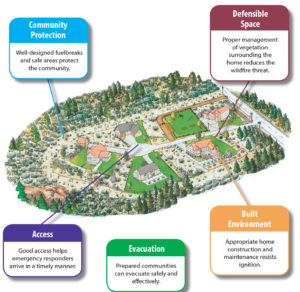Preparing for Wildfire is More Than Evacuation and Defensible Space
September 19th, 2017
Having spent the majority of my life in Nevada, I’ve seen my share of wildfires. Growing up, I remember helping my father pick the weeds from the common area behind our house to improve our defensible space and even preparing items at home for an evacuation. Before starting with the Living With Fire Program, this is what I thought wildfire preparedness entailed. Since then, I’ve learned that there are five categories of actions to help residents prepare for wildfire. Those categories include: Access, Built Environment, Community Protection, Defensible Space and Evacuation. One easy way to remember these elements is to just remember your “ABCs and Ds and Es!”
Access: This is how you and emergency services get in and out of your community. Some examples of proper access in your community include: local fire services have key access to your gated driveways, long driveways or dead-end roads have enough room for emergency vehicles to turn around, your home’s address is readily visible from the street, there is at least a 13 ½-foot vertical clearance for your driveway, and that there are at least two ways out of the community.
Built Environment: The maintenance of a home and the manner in which it is built can improve the odds of a home surviving a wildfire. Maintaining a deck and how a deck is built is one example of the built environment. For example, it’s recommended to keep all deck materials in good condition and to consider using fire-resistant-rated materials. Residents should habitually check the deck for combustible debris (pine needles, leaves, twigs and weeds) under the deck and between deck boards. They should also consider enclosing the sides of the deck and to not store combustible materials under it.
Community Protection: Two ways to improve your community’s protection is via fuel breaks and community safe areas. A fuel break is a strip of land that has had highly flammable vegetation removed to reduce the wildfire threat. A safe area is a designated spot within a community where residents can stay to wait out the wildfire. Examples of safe areas include: ball fields, irrigated pastures, parks and parking lots.
Defensible Space: This is the area between a home and an oncoming wildfire where the vegetation was managed to reduce the wildfire threat and allow firefighters to safely defend the home. An effective defensible space includes knowing the proper distance for vegetation management, removing dead vegetation, thinning dense trees and shrubs, removing ladder fuels, and creating a “Lean, Clean, and Green” area around the house.
Evacuation: Residents should prepare for evacuation long before a wildfire occurs. This includes developing a family evacuation plan, assembling a To-Go bag, and knowing what to wear and take when evacuating.
I only reviewed a small portion of this information. For more in-depth information regarding these five categories, please view “Fire Adapted Communities: The Next Step in Wildfire Preparedness” . I urge all residents to check out this great publication and to prepare for wildfire.

Jamie Roice-Gomes
Jamie Roice-Gomes is the outreach coordinator with University of Nevada Cooperative Extension’s Living with Fire Program. She earned her Bachelor of Science in Wildlife Ecology and Conservation and a Master of Arts in Interactive Environmental Journalism. She was a public relations assistant for Conrad Communications, a public information officer intern at the Nevada Department of Conservation & Natural Resources, and a Biological Science Technician at the USDA-Agriculture Research Service. She also enjoys volleyball, the Great Basin Desert, and spending time with family. Contact Jamie at 775-336-0261 or roicej@unce.unr.edu.
